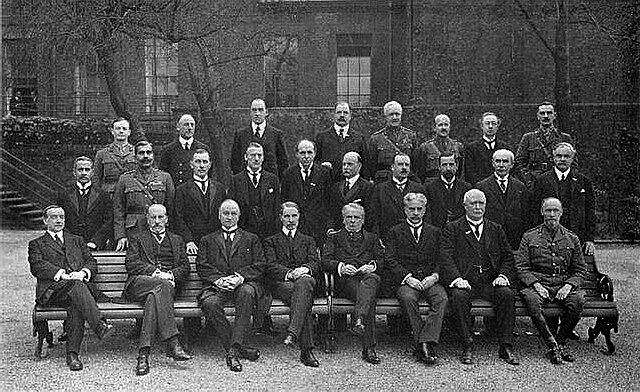Top Qs
Timeline
Chat
Perspective
Lloyd George ministry
Government of the United Kingdom from 1916 to 1922 From Wikipedia, the free encyclopedia
Remove ads
Liberal David Lloyd George formed a coalition government in the United Kingdom in December 1916, and was appointed Prime Minister of the United Kingdom by King George V. It replaced the earlier wartime coalition under H. H. Asquith, which had been held responsible for losses during the Great War.[2] Those Liberals who continued to support Asquith served as the Official Opposition. The government continued in power after the end of the war in 1918, though Lloyd George was increasingly reliant on the Conservatives for support. After several scandals including allegations of the sale of honours, the Conservatives withdrew their support after a meeting at the Carlton Club in 1922, and Bonar Law formed a government.[2]
Remove ads
Remove ads
Cabinets
War Cabinet, December 1916 – January 1919

- George Curzon, 1st Earl Curzon of Kedleston – Lord President of the Council and Leader of the House of Lords
- Bonar Law – Chancellor of the Exchequer and Leader of the House of Commons
- Arthur Henderson – Minister without Portfolio
- Alfred Milner, 1st Viscount Milner – Minister without Portfolio
Changes

- May – August 1917 – In temporary absence of Arthur Henderson, George Barnes, Minister of Pensions acts as a member of the War Cabinet.
- June 1917 – Jan Smuts enters the War Cabinet as a Minister without Portfolio
- July 1917 – Sir Edward Carson enters the War Cabinet as a Minister without Portfolio
- August 1917 – George Barnes succeeds Arthur Henderson (resigned) as Minister without Portfolio and Labour Party member of the War Cabinet.
- January 1918 – Carson resigns and is not replaced
- April 1918 – Austen Chamberlain succeeds Lord Milner as Minister without Portfolio.
- January 1919 – Law becomes Lord Privy Seal, remaining Leader of the House of Commons, and is succeeded as Chancellor of the Exchequer by Chamberlain; both remaining in the War Cabinet. Smuts is succeeded by Sir Eric Geddes as Minister without Portfolio.
Peacetime Cabinet, January 1919 – October 1922
- Note: The War Cabinet was formally maintained for much of 1919, but as Lloyd George was out of the country for many months this made little difference; in October 1919 a formal Cabinet was reinstated.
- David Lloyd George – Prime Minister
- F.E Smith, 1st Baron Birkenhead – Lord Chancellor
- George Curzon, 1st Baron Curzon of Kedleston – Lord President of the Council and Leader of the House of Lords
- Bonar Law – Lord Privy Seal and Leader of the House of Commons
- Austen Chamberlain – Chancellor of the Exchequer
- Edward Shortt – Secretary of State for the Home Department
- Arthur Balfour – Secretary of State for Foreign Affairs
- Alfred Milner, 1st Viscount Milner – Secretary of State for the Colonies
- Winston Churchill – Secretary of State for War and Air
- Edwin Montagu – Secretary of State for India
- Walter Long – First Lord of the Admiralty
- Sir Albert Stanley – President of the Board of Trade
- Robert Munro – Secretary for Scotland
- Ian Macpherson – Chief Secretary for Ireland
- John French, 1st Viscount of Ypres – Lord-Lieutenant of Ireland
- Christopher Addison – President of the Local Government Board
- Rowland Prothero – President of the Board of Agriculture
- H. A. L. Fisher – President of the Board of Education
- Andrew Weir, 1st Baron Inverforth – Minister of Munitions
- Sir Robert Horne – Minister of Labour
- George Barnes – Minister without Portfolio
- Sir Eric Geddes – Minister without Portfolio
Changes
- May 1919 – Sir Auckland Geddes succeeds Sir Albert Stanley as President of the Board of Trade. Sir Eric Geddes becomes Minister of Transport.
- October 1919 – Lord Curzon of Kedleston succeeds Balfour as Foreign Secretary. Balfour succeeds Curzon as Lord President. The Local Government Board is abolished. Christopher Addison becomes Minister of Health. The Board of Agriculture is abolished. Lord Lee of Fareham becomes Minister of Agriculture. Sir Eric Geddes becomes Minister of Transport.
- January 1920 – George Barnes leaves the cabinet.
- March 1920 – Sir Robert Horne succeeds Sir Auckland Geddes as President of the Board of Trade. Thomas James McNamara succeeds Horne as Minister of Labour.
- April 1920 – Sir Hamar Greenwood succeeds Ian Macpherson as Chief Secretary for Ireland. Sir Laming Worthington-Evans joins the Cabinet as Minister without Portfolio.
- February 1921 – Winston Churchill succeeds Lord Milner as Colonial Secretary. Sir Laming Worthington-Evans succeeds Churchill as War Secretary. Churchill's successor as Air Secretary was not in the Cabinet. Lord Lee of Fareham succeeds Walter Long at the Admiralty. Sir Arthur Griffith-Boscawen succeeds Lee as Minister of Agriculture.
- March 1921 – Austen Chamberlain succeeds Bonar Law as Lord Privy Seal and Leader of the Commons. Sir Robert Horne succeeds Chamberlain at the Exchequer. Stanley Baldwin succeeds Horne at the Board of Trade.
- April 1921 – Lord French resigns from the cabinet, remaining Lord Lieutenant. Christopher Addison becomes a Minister without Portfolio. Sir Alfred Mond succeeds him as Minister of Health. The Ministry of Munitions is abolished.
- November 1921 – Sir Eric Geddes resigns from the cabinet. His successor as Minister of Transport is not in the Cabinet. The Attorney General, Sir Gordon Hewart, enters the Cabinet.
- March 1922 – William Peel, 2nd Viscount Peel succeeds Edwin Montagu as India Secretary.
- April 1922 – The First Commissioner of Works, David Lindsay, 27th Earl of Crawford, enters the Cabinet.
Remove ads
List of ministers
Summarize
Perspective
Members of the Cabinet are listed in boldface. Members of the War Cabinet, 6 December 1916 to 31 October 1919, are indicated.
| Conservative Liberal Labour |
Remove ads
References
Further reading
Wikiwand - on
Seamless Wikipedia browsing. On steroids.
Remove ads

